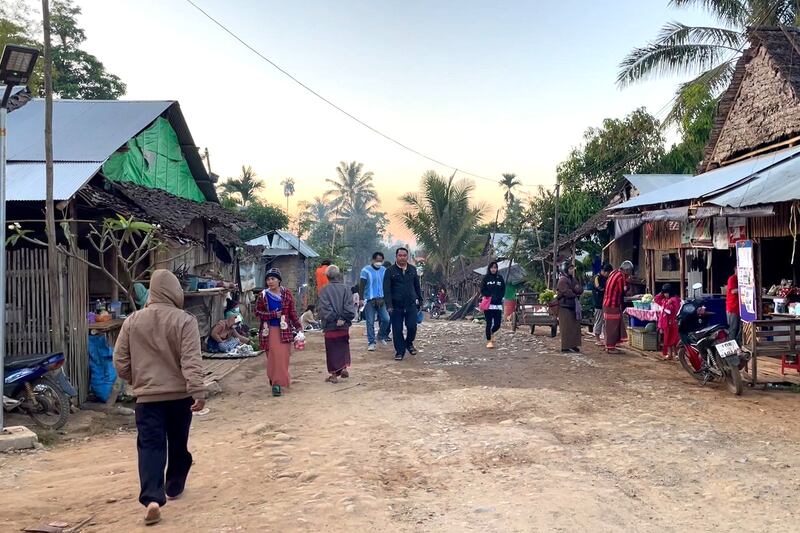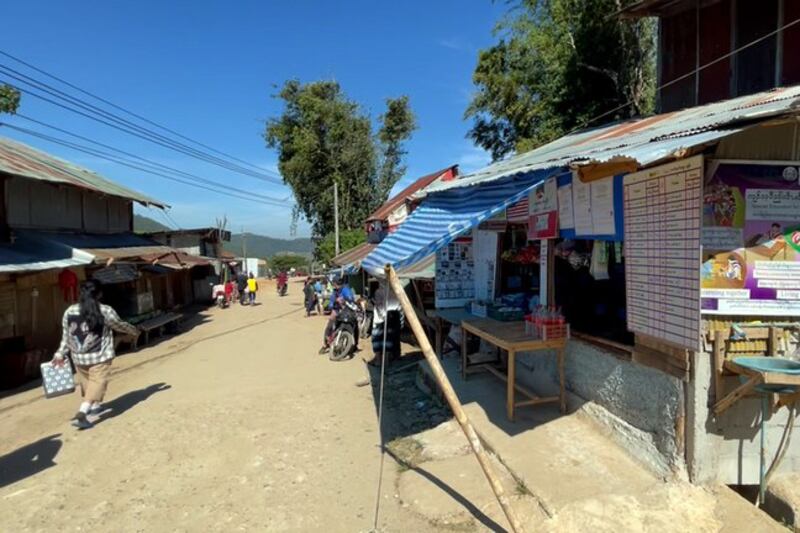Read RFA coverage of this story in Burmese.
Updated at Feb. 13, 2025, 1:14 p.m. ET
UMPIEM MAI REFUGEE CAMP, Thailand — Saw Ba had been living in a refugee camp on the Thai-Myanmar border for 16 years when he got the news last month that he’d been waiting years for: He and his family would be boarding a plane to resettle in America.
It had been a long wait. Saw Ba, in his 40s and whose name has been changed in this story for security reasons, had applied for resettlement soon after getting to the camp in 2008.
With much anticipation, staffers from the International Organization for Migration, or IOM, brought his family and 22 other people from Umpiem Mai Refugee Camp to a hotel in the Thai border town of Mae Sot in mid-January.
There they were to wait to catch a flight to Bangkok and on to the United States.
Freedom and a new life awaited.
But three days later, the IOM staffers delivered bad news: All 26 people would have to return to the refugee camp because the incoming Trump administration was about to order a halt to the processing and travel of all refugees into the United States.
A few days later, after his Jan. 20 inauguration, U.S. President Donald Trump signed an executive order suspending refugee resettlement as part of a broader effort to “immediately end the migrant invasion of America.”
The executive order said the United States “lacks the ability to absorb large numbers of migrants, and in particular, refugees, into its communities in a manner that does not compromise the availability of resources for Americans, that protects their safety and security, and that ensures the appropriate assimilation of refugees.”
Back in his family’s barren, ramshackle hut in the camp, Saw Ba was crestfallen.
“We have lost our hope now,” he said.
Left in Limbo
Saw Ba’s family is among hundreds or perhaps thousands of refugees globally who were held back on the cusp of entering the United States.
According to the Associated Press, a little more than 10,000 refugees worldwide had already been vetted and had scheduled travel to the United States ahead of the Jan. 20 deadline. It was not clear how many actually entered the United States before that date.
At Umpiem Mai camp, around 400 refugees had been waiting for resettlement in the United States.
Now they will have to wait longer.
Saw Ba and his family had been so sure they would be resettled that they had given all of their belongings — including their clothes — to neighbors and friends, while their children had dropped out of school and returned their books.
“When we arrived back here [at Umpiem], we had many difficulties,” he told RFA Burmese, particularly with their children’s education.
“Our children have been out of school for a month, and now they’re back, and their final exams are coming up,” he said. “Our children won’t have books anymore when they return to school. I don’t know whether they’ll pass or fail this year’s exams.”
Missionary work
Saw Ba fled to the refugee camp because he was targeted for his Christian missionary work.
Originally from Pathein township, in western Myanmar’s Ayeyarwady region, he was approached by an official with the country’s military junta in 2009 and told to stop his activities.
When he informed the official that he was not involved in politics and refused to comply, police were sent to arrest him.
He fled to Thailand, where he ended up in the Umpiem Mai camp. There he met his wife and had a son and daughter, now in seventh and second grade, respectively.
RELATED STORIES
Vietnamese in Thailand wait anxiously after Trump suspends refugee program
Myanmar aid groups struggle with freeze as UN warns of ‘staggering’ hunger
Tide of Myanmar war refugees tests Thailand’s welcome mat for migrants
Another woman in the camp, Thin Min Soe, said her husband and their two children had undergone a battery of medical tests and had received an acceptance letter for resettlement, allowing them to join a waitlist to travel.
She had fled her home in the Bago region in central Myanmar for taking part in the country’s 2007 Saffron Revolution, when the military violently suppressed widespread anti-government protests led by Buddhist monks.
Thin Min Soe and other refugees at the camp told RFA they are afraid of returning to Myanmar due to the threat of persecution. The country has been pitched into civil war after the military toppled an elected government in 2021. Many said they no longer have homes or villages to return to, even if they did want to go back.
With the U.S. refugee program suspended, “we are now seriously concerned about our livelihood because we have to support our two children’s education and livelihoods,” she said.
When RFA contacted the camp manager and the refugee affairs office, they responded by saying they were not allowed to comment on the matter.
US has resettled 3 million refugees
Since 1980, more than 3 million refugees — people fearing persecution because of their race, religion, nationality, politics or membership in a social group — have been resettled in the United States.
During the fiscal year that ended Sept. 30, the United States resettled 100,034 refugees, the highest number in 30 years. The most came from the Republic of the Congo, followed by Afghanistan, Venezuela and Syria. Myanmar was fifth, accounting for 7.3%, according to the Center for Immigration Studies.
Over the past 30 years, the United States accepted the highest number of refugees from Myanmar — about 76,000 — followed by Canada and Australia, according to the U.S. Embassy in Thailand.
Hundreds of Myanmar refugees from Thailand were brought to the U.S. in November and December, before the end of former President Joe Biden’s term.

Requests by RFA for comment on the situation from the IOM and the U.S. Embassy in Thailand were not immediately returned.
The Border Consortium — the main provider of food, shelter and other forms of support to the approximately 120,000 refugees from Myanmar living in nine camps in western Thailand — told RFA in an emailed statement that the food and cooking fuel it distributes is funded by a U.S. grant, but said it had not received an order to stop its activities.
“We are currently operating and providing food to refugees as normal, but the money in hand will last for a month or a month and a half,” Maximillian Morch, TBC’s manager for advocacy, communication and reports, said in an emailed statement. “That is why it is so important that the U.S. decides to continue feeding these refugees.”
Morch said that one month of food costs approximately US$1.3 million and TBC would look for ad hoc contributions from other donors or the private sector, but “it is too early to say” whether they will find alternative funding.
“TBC may have to move very pragmatically and try to fill the gap each month until a final decision is made by the U.S. State Department,” he said, suggesting that it could be up to five months before the issue is resolved.
An aid worker from the region told RFA that the refugees who were sent back to Umpiem Mai were sure to face challenges reintegrating in the camp.
“When they return, they will have difficulty getting food and finding accommodations,” said the aid worker, who also declined to be named. “They have already given their belongings to relatives, and some have been sold.”
Thai medical services
Thai officials, meanwhile, are working to provide medical care at camps for Myanmar refugees where health services have been affected by a recent suspension of U.S. foreign aid, also activated by Trump under an executive order.
The suspension prompted a Feb. 3 meeting of officials from the nine camps for Myanmar refugees along the border and Thai authorities and hospital officials.
They agreed that the camps will continue to use clinics and equipment provided by the U.S.-based humanitarian aid provider International Rescue Committee, or IRC, to treat camp residents, according to Saw Pwe Say, the secretary of the ethnic Karen Refugee Committee.
“I felt relieved ... they said the IRC has approved the camps to continue using their clinics and equipment for medical treatment,” he said.

Thai health workers will provide healthcare during the day from Monday to Friday, while refugee camp health professionals will be on duty at night and on weekends.
The U.S. freeze on foreign aid has also impacted the work of other humanitarian groups at the Thai-Myanmar border, including the Mae Tao Clinic, which provides free medical care to those in need, as well as health education and social services, officials told RFA.
Translated by Aung Naing and Kalyar Lwin. Edited by Joshua Lipes and Malcolm Foster.
This story has been updated to include a statement from The Border Consortium.
